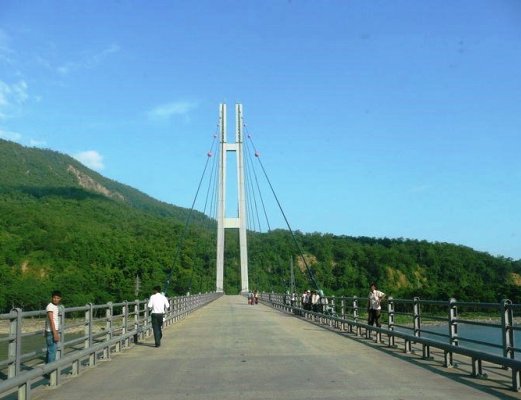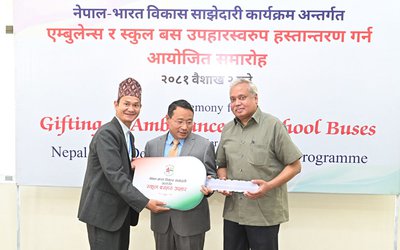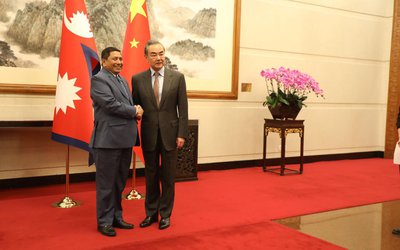
It has given two prime ministers. They came from different backgrounds. They belonged to the two different regimes. The region that sent the country's two executive chiefs to Kathmandu also boasts of huge potential to make a mark on national development scene, but it is limited to the hollow pride on the national political scene. Yes, the far western region comprising Seti and Mahakali zones may have stolen the political limelight (incidentally, the country's first woman minister also hails from this region), but it lives in the development darkness. Education, health, infrastructures, industries and trade. Name any areas and the far west finds itself far behind the other four regions.
Krishni Chaudhary of Basauti VDC in Kailali struggles to hold her child onto her fragile body. The 18 year old looks mature for her age thanks to her early marriage and the routine household chores. She quit school at the age of 15. Despite receiving scholarship from the government, Krishni was forced to drop out after she flunked in the final examination. Her family would no longer support her education. She couldn’t get through because she had very little time to study at home.
“I was never regular at the school. Whenever there was more work at home than usual, I would have to stay back and help my mother”, says Krishni. Married at 16, she now has a kid to look after and is responsible for all household chores. She even has to manage to help in-laws in the field. Her husband has been working in India since last year. She says she wants to study but it is impossible since her in-laws are against it.
Krishni is one of the many girls in the far western district of Kailali who has dropped out of school at an early age. Almost 50 percent of girls in the district aged 15-19 are not enrolled in school. They are forced to leave school for a variety of reasons ranging from poverty to marriage. The problem is not just limited to Kailali. A recent study conducted by UNICEF in the adjoining districts including Doti, Accham, Bajura and Baitadi showed alarming drop-out rate amongst adolescent girls making it a major problem in the region.
But that is just one of the many problems plaguing the Far West region of Nepal. The region continues to be characterized by high level of poverty, low human development, increasing migration, stalled development and high gender disparity. Often referred to as the most neglected region due to its remoteness from the central administration, the Far West remains much behind other parts of the country despite development efforts from the government and donors in the recent past.
Low Human Development
According to the Human Development Index (HDI) Report 2014, the Far West recorded 0.435, the lowest in the country. Seven out of the nine districts in the region featured at the bottom of the table -- with Bajhang and Bajura taking the last two positions. There are very little health facilities, literacy level is low and people live under harrowing circumstances. Almost half of the population is living under the poverty line.
One of the major factors contributing to this low HDI is poor hygiene and sanitation practices. Despite growing awareness and the execution of many health projects, only 51.54 per cent of the total population have access to safe drinking water and a meagre 25.31 per cent have access to toilets. Although the Open Defecation Free (ODF) movement has gained momentum with Achham being the first district to be declared an ODF zone in the region, it’s effectiveness remains questioned. Many villages still do not have toilets. Even in the few VDCs which have been declared open defecation free, lack of proper maintenance has led people to go back to open defecation.
Absence of proper health facilities has been another major problem. In 2009, hundreds of people lost lives after a deadly cholera that broke out in the neighboring Jajarkot in the mid west region spread to districts in Far West. Five years down the lane, the region still remains unprepared for such an outbreak. Doctors warned of another epidemic after a test conducted last year showed cholera virus in drinking water supplied to the hilly area of the region. To make matters worse, almost all the hospitals in the hilly areas do not have experienced doctors. The two main hospitals, Seti Zonal Hospital and Mahakali Zonal Hospital, are overcrowded and have been running without specialist doctors for years. The villagers have no choice but to go to India for treatment.
Lack of education and drop out is another big challenge. The school enrolment ratio for girls is only 48% while it is 52% for boys. What’s more worrying is the drop out amongst the enrolled students. The literacy rate for those over 15 years is much lower than those over 6 which reflecting the trend of dropping out. Instead of continuing school, migrating to India provides better a return for the locals. “When I can go to India and earn enough money to support my family for one year, why should I bother studying here,” asks Bishwa Khadka of Durgamandu VDC in Doti, who has just dropped out to leave for Mumbai.
Snail-Paced Development
The Far West region started seeing development very late compared to other regions. Having given the country two Prime Ministers and the first woman minister of Nepal, the region picked up pace in terms of development only after the introduction of multi party democracy in 1990. Construction of roads and bridges took place and some industries were established. The construction of the Karnali bridge was a major turning point for the region's economy. But the decade long Maoist insurgency pushed the region back. Thousands were killed, infrastructures destroyed, market access was for the region was limited and investment came to a halt. Development took a hit.
Things haven’t improved despite the end of the insurgency. With limited job and livelihood opportunities, many youths continue to leave abroad or better opportunities. Due to its proximity, India has been the popular destination. Slowly now, Gulf countries have started to attract the locals with the result that villages are inhabited mostly by women. Although people rely heavily on agriculture, low productivity, poor rural infrastructure and inaccessibility to the market are having a heavy toll on farming. This has further encouraged migration. Worse, many men who come back suffer from diseases like AIDS and TB.
“It is unfortunate that the region which has so much scope has to meet such a fate,”says Ganesh Bhatta, eminent lawyer who hails originally from Dadeldhura. “The region has huge potential for the development of agro- based businesses, cement and carpet industries and hydro power projects. But it has not been able to tap the potentials. Not that nothing has taken place, but it is far from the potential that the region does posses”, he says. Recalling how it used to take as many as four days to reach Kathmandu from Dhangadhi during his college days some three decades ago, Bhatta says, "It would be wrong to say that development hasn’t taken place at all but the problem is that it has been painfully slow.” Some hotels and banks have sprouted, but the economy is yet to get a major boost. Two major hydropower projects, West Seti and Chameliya, have been in the making but they have been subjected to one obstacle after another.. While the former is yet to get a kick start, the latter’s finalization date has been postponed more than five times.
“Even the existing industries closed down because of politicization,” says Umid Bagchan, a Dhangadi based journalist. Rosin and Turpentine and Vashuling Sugar Mills are some examples. “Despite the end of war, the government has failed to promote business environment in the region. The economy is in tatters, adds Bagchan. Although the region boasts of tourist destinations like Khaptad National Park, Suklaphanta Wildlife Reserve, Saipal Himalayas and Rama Roshan lakes, it hardly sees visitors.
The region is a regular witness to natural disasters such as floods, landslides and forest fires. Every year during the monsoon season, floods affect thousands of people in the Terai while landslides triggered by torrential rains cause loss of lives and property in the Hill and Mountain areas. Along with lives lost, infrastructures are destroyed. Landslides in Darchula and Bajura in 2009 damaged houses, land and community infrastructure. Rural roads, irrigation canals and trails were the major casualties. The government, however, has taken little interest to build them again.
Government and Donor Interest
In the recent past, however, the region has slowly started seeing the influx of development funds mainly due to the interest shown by donor agencies. Many VDCs have seen some kind of NGO intervention. NGOs as well as INGOs can be spotted in a number of places. The locals are now eagerly looking forward to the Indian-aided multi-lane motorable bridge over Mahakali River at Mahendranagar, which will allow traffic along the East West Highway to cross over the Mahakali River and establish a vital trade and transit linkage of far western region of Nepal with Indian cities of Uttar Pradesh, Delhi and Uttarakhand.
But compared to the poverty level in the region, the allocation of government budget for the region's development looks like peanut. According to the Development Cooperation Report 2012/13, the Far West region received only 14 percent of total aid provided by the donors in 2013. Although the budget for the region increased to 18.19 billion, up by 19 percent from last year, the amount barely compared with what the other regions received.
The authorities say, the government is sensitive to the issues facing the far western region. Said member of Nepal Planning Commission Swarnim Wagle, “although there are no separate plans meant only for the region, the development strategies of the 13th Development Plan covers the Far West. Referring to the Far Western Region Development Commission formed by the government two years ago to initiate development planning in the region, Wagle said that development would be more effective if a consolidated body like the National Planning Commission took charge of the planning.
The low absorption capacity of the region is also to be blamed for the amount of the resources it gets. Due to poor infrastructures development and low education level, the aid meant for the region has not been spent well. There have been some movements on infrastructure thanks to the donor-assisted projects, but road networks across the region are still abysmally poor.
Long Way to Go
So what ails the country's most backward and neglected region? A comprehensive and sustainable development plan and its proper execution, say experts. Without a sustainable approach, the region is less likely to change for the better. Equally important is proper planning. “Institutions need to be strengthened and the government should create an environment for development," says Bhatta. As the region has immense scope for producing raw materials, the government should focus on establishing industries that feed on such raw materials. No less important is the opening of market centres across the region to enable the local farmers to get the best bargain for their produce so that their living improves and migration abroad for job is discouraged.
"Unfortunately, there has been no concrete move to change the face of the region," laments Bagchan, "There are very few have sustainable development projects in operation." At the most, he says, there have been cosmetic developments only. As long as this continues, the region will continue to languish in the perpetual underdevelopment.
Reporting from Dhangadhi
- Ukrainian Crisis And The World (Dis)Order
- Apr 22, 2022
- China’s Cautious Steps In The Graveyard Of Empires
- Aug 18, 2021
- Foreign Aid On The Fence!
- Aug 08, 2021
- Communist Party of China centenary celebrations Reading between the lips
- Jul 14, 2021
- Second Wave Of Covid-19 In India: Deadly Blow To The Economy
- Jun 23, 2021

















